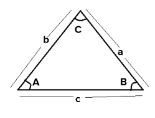
If \[a,b,\]and \[c\]are the sides of a triangle such that \[{a^4} + {b^4} + {c^4} = 2{c^2}({a^2} + {b^2})\] then find the angle opposite to side \[c\].
A. \[{45^o}\]or \[{135^o}\]
B. \[{30^o}\]or \[{100^o}\]
C. \[{50^o}\]or \[{100^o}\]
D. \[{60^o}\]or \[{120^o}\]
Answer
219k+ views
Hint:
In the given question, we need to find the angle opposite to side \[c\]. For this, we will simplify the given equation and also use the trigonometric identities to get the desired result.
Formula Used:
In \[ \Delta ABC \],
By cosine rule: \[\cos C = \dfrac{{{a^2} + {b^2} - {c^2}}}{{2ab}}\]
\[(a+b+c)^{2} = a^{2} + b^{2} + c^{2} + 2ab + 2bc + 2ca\]
Complete step-by-step answer:
Consider the following figure.

In \[ \Delta ABC \], angle \[C\] is the opposite angle to side \[c\]
Given expression: \[{a^4} + {b^4} + {c^4} = 2{c^2}({a^2} + {b^2})\]
Now, we will simplify the expression,
\[{a^4} + {b^4} + {c^4} = 2{c^2}{a^2} + 2{c^2}{b^2}\]
\[{a^4} + {b^4} + {c^4} - 2{c^2}{a^2} - 2{c^2}{b^2} = 0\]
By adding \[2{a^2}{b^2}\] on both sides, we get;
\[{a^4} + {b^4} + {c^4} - 2{c^2}{a^2} - 2{c^2}{b^2} + 2{a^2}{b^2} = 2{a^2}{b^2}\]
\[{\left( {{a^2} + {b^2} - {c^2}} \right)^2} = 2{\left( {ab} \right)^2}\]
Now, by taking square root on both sides, we get
\[\left( {{a^2} + {b^2} - {c^2}} \right) = \pm \sqrt 2 \left( {ab} \right)\]
Divide by \[2\] on both sides.
\[\dfrac{{\left( {{a^2} + {b^2} - {c^2}} \right)}}{2} = \dfrac{{ \pm \sqrt 2 \left( {ab} \right)}}{2}\]
By simplifying, we get;
\[\dfrac{{\left( {{a^2} + {b^2} - {c^2}} \right)}}{{2ab}} = \dfrac{{ \pm \sqrt 2 }}{2}\]
Since, by cosine rule: \[\cos C = \dfrac{{{a^2} + {b^2} - {c^2}}}{{2ab}}\]
\[\Rightarrow \cos C = \dfrac{{ \pm 1}}{{\sqrt 2 }}\]
Therefore, \[\angle C = {45^o}\] or \[\angle C = {135^o}\]
Hence, the correct option is (A).
Note:
Many students make mistakes in the calculation part as well as writing trigonometric identity. This is the only way through which we can solve the example in the simplest way. Also, it is essential to get the correct angle \[C\].
In the given question, we need to find the angle opposite to side \[c\]. For this, we will simplify the given equation and also use the trigonometric identities to get the desired result.
Formula Used:
In \[ \Delta ABC \],
By cosine rule: \[\cos C = \dfrac{{{a^2} + {b^2} - {c^2}}}{{2ab}}\]
\[(a+b+c)^{2} = a^{2} + b^{2} + c^{2} + 2ab + 2bc + 2ca\]
Complete step-by-step answer:
Consider the following figure.

In \[ \Delta ABC \], angle \[C\] is the opposite angle to side \[c\]
Given expression: \[{a^4} + {b^4} + {c^4} = 2{c^2}({a^2} + {b^2})\]
Now, we will simplify the expression,
\[{a^4} + {b^4} + {c^4} = 2{c^2}{a^2} + 2{c^2}{b^2}\]
\[{a^4} + {b^4} + {c^4} - 2{c^2}{a^2} - 2{c^2}{b^2} = 0\]
By adding \[2{a^2}{b^2}\] on both sides, we get;
\[{a^4} + {b^4} + {c^4} - 2{c^2}{a^2} - 2{c^2}{b^2} + 2{a^2}{b^2} = 2{a^2}{b^2}\]
\[{\left( {{a^2} + {b^2} - {c^2}} \right)^2} = 2{\left( {ab} \right)^2}\]
Now, by taking square root on both sides, we get
\[\left( {{a^2} + {b^2} - {c^2}} \right) = \pm \sqrt 2 \left( {ab} \right)\]
Divide by \[2\] on both sides.
\[\dfrac{{\left( {{a^2} + {b^2} - {c^2}} \right)}}{2} = \dfrac{{ \pm \sqrt 2 \left( {ab} \right)}}{2}\]
By simplifying, we get;
\[\dfrac{{\left( {{a^2} + {b^2} - {c^2}} \right)}}{{2ab}} = \dfrac{{ \pm \sqrt 2 }}{2}\]
Since, by cosine rule: \[\cos C = \dfrac{{{a^2} + {b^2} - {c^2}}}{{2ab}}\]
\[\Rightarrow \cos C = \dfrac{{ \pm 1}}{{\sqrt 2 }}\]
Therefore, \[\angle C = {45^o}\] or \[\angle C = {135^o}\]
Hence, the correct option is (A).
Note:
Many students make mistakes in the calculation part as well as writing trigonometric identity. This is the only way through which we can solve the example in the simplest way. Also, it is essential to get the correct angle \[C\].
Recently Updated Pages
In a game two players A and B take turns in throwing class 12 maths JEE_Main

The number of ways in which 6 men and 5 women can dine class 12 maths JEE_Main

The area of an expanding rectangle is increasing at class 12 maths JEE_Main

If y xxx cdots infty then find dfracdydx A yxy 1 B class 12 maths JEE_Main

Chemical Properties of Hydrogen - Important Concepts for JEE Exam Preparation

JEE General Topics in Chemistry Important Concepts and Tips

Trending doubts
JEE Main 2026: Application Form Open, Exam Dates, Syllabus, Eligibility & Question Papers

Derivation of Equation of Trajectory Explained for Students

Hybridisation in Chemistry – Concept, Types & Applications

Understanding the Angle of Deviation in a Prism

Understanding Collisions: Types and Examples for Students

Understanding Atomic Structure for Beginners

Other Pages
JEE Advanced Marks vs Ranks 2025: Understanding Category-wise Qualifying Marks and Previous Year Cut-offs

How to Convert a Galvanometer into an Ammeter or Voltmeter

Understanding Centrifugal Force in Physics

JEE Main Marking Scheme 2026- Paper-Wise Marks Distribution and Negative Marking Details

Degree of Dissociation: Meaning, Formula, Calculation & Uses

Understanding Electromagnetic Waves and Their Importance




